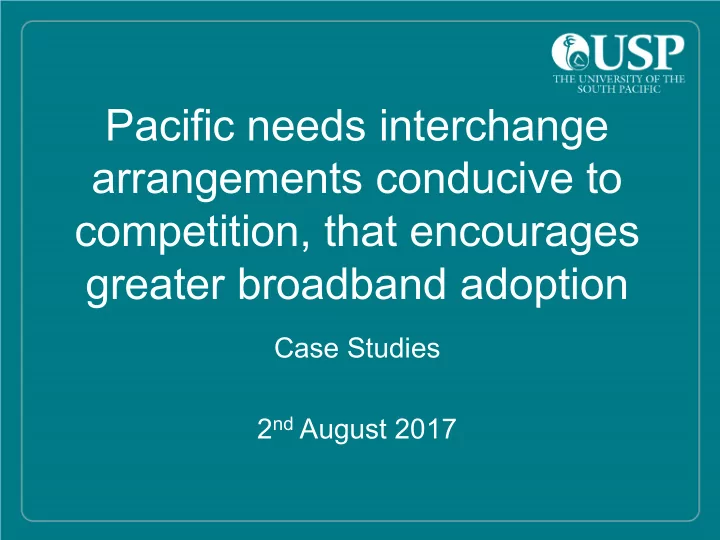

Pacific needs interchange arrangements conducive to competition, that encourages greater broadband adoption Case Studies 2 nd August 2017
Outline • Introduction • Submarine Cable Map • Costs • Case Studies • Conclusions • Recommendations
Introduction • Information, Communication Technologies (ICT) and Knowledge are crucial for all our survival, prosperity, and competiveness for engaging with the world system. • Broadband access is the fundamental infrastructure underlying ICT development and application, just as ships, roads and air travel have been the infrastructure for historic goods and services.
Introduction • ICT and knowledge, supported by modern broadband, are the most important drivers of contemporary economic, social and educational development, which is why the world economy is now often referred to as the knowledge economy • Fiji and the Pacific region are no different. In fact, as Small Island developing states, ICT and broadband access are the major connective tissue with the world and even more critical for development in Pacific Island countries
Introduction • This Case Studies and presentation is to address Interconnection in Fiji and the negative impact on Fiji and our region. • This particularly applies to the decision of the Commerce Commission on the costs at the Landing Station (FINTEL)
Submarine Cables in Pacific • Fiji was the first country in the South Pacific Region to be connected to the Submarine Cable (Southern Cross). • Tonga submarine cable is connected to Fiji • Vanuatu Submarine cable is connected to Fiji • Tui Samoa submarine cable is connecting to Fiji
Submarine Cables Map • [Insert maps]
Costs of Interconnection in Fiji • (One-Off-Charge): This is a one-off charge and attracts a 15% of Capacity Acquisition Costs - that is 15% of the actual acquisition cost. • Interconnect services & maintenance $4000.00 per STM1 a month • Co-location charges $125/sq.ft (per month)
Case Studies • Typical fiber connection in various gateways surveyed which ranges from US $200 - $500 per month – • it is significant to note that this is a flat fee and this is not dependent on link bandwidth speeds but is a port charge only. • As another example, a cross-connection for a link through Guam’s PITI Terminal is currently US $100 per month.
Case Studies
Case Studies Other ICT Development in the Pacific • The University of Hawaii is leading an international initiative to establish an Open Research & Education (R&E) exchange in Guam. • The open R&E exchange will utilize the existing, funded and planned high capacity R&E Trans-Pacific circuits in an intentional manner. • This includes both major international systems connecting Southeast Asia, North Asia, Australia and North America as well as the smaller regional systems connecting the Marshall Islands, Federated States of Micronesia and Palau. • The open market in Guam makes it feasible to interconnect these systems.
Case Studies Other ICT Developments in the Pacific • Samoa recently announced that with their new submarine cable, their Prime Minister wants Samoa to be the ICT hub for the Pacific. With four (4) submarine cables planned to be landed in Samoa, • He wants Samoa to take advantage of the opportunity to assist other Pacific Island neighbors by becoming the first ICT Hub for the Pacific Region.
Case Studies USP’s Roadmap involves the following key strategies: • Acquisition of submarine fiber-optic capacity between its regional member countries to allow for greater connectivity and accessibility to its education and research services by regional campus students. • Development of high capacity data centers in campuses connected fiber- optic for ease of replication of data and services for a more resilient network. • Collaborating and connecting up local Fiji Educational Institutes such as Fiji National University and University of Fiji which would officially establish Fiji’s very own Research and Educational Network similar to AARNet in Australia or Internet2 in the U.S. • The development of High Performance Computing (HPC) infrastructure to host and process information like Climate Change Data in within USP for more accurate modelling of climate and weather patterns – benefitting Fiji and all nations of the Pacific Region.
Research & Education Network • What is the Research & Education Network ? • A REN is specialized ICT Service Provider dedicated to supporting the needs of the research and education communities within a country or region. It is usually distinguished by a high speed backbone network offering dedicated capacity for research projects.
AARnet Connection
Case Studies • Fiji’s geographical location and standing as the first country in the region with submarine fiber optic cable should have positioned us as the leader. • In terms of Research and Education Network, that is now gravitating to Guam. • Samoa is also positioning itself, potentially with multiple fiber systems.
Conclusions • Fibre optic submarine cable remains the optimum medium for inter-island connectivity; • Broadband access to small island developing states in the Pacific critical to ICT development; • ICT development and infrastructure directly linked to economic development; • Fiji has access to major fibre optic submarine cables, in order to be ICT hub of the Pacific;
Recommendations • Although the Telecom Industry is deregulated in Fiji, one of the major drawback continues to be the cost of the landing station charges set by the Commerce Commission. • Fiji needs to review the Landing Costs to reflect international market prices.
Recommendations • These costs are high and structurally unlike what prevails at other cable landing stations and major IT hubs. • C urrent practices actually harms Fiji’s aspiration to be the Pacific Fiber ICT Interchange. • If the charging regime in Fiji gateway is not brought into line with the charging behavior and regimes of other hubs, it is likely that entities with any reasonable option will work to bypass Fiji.
Recommend
More recommend